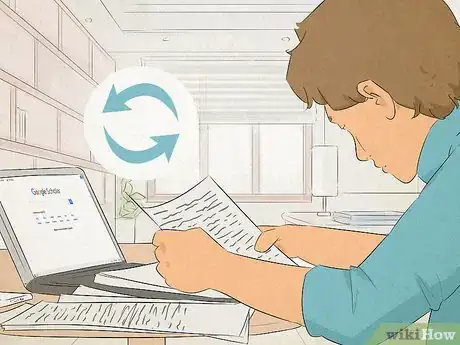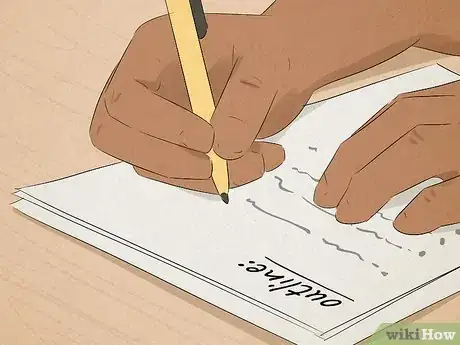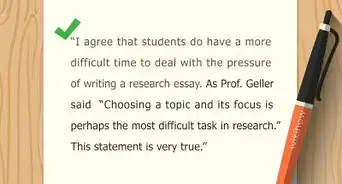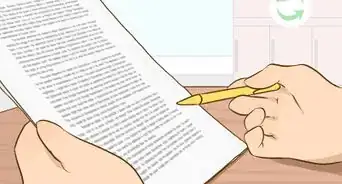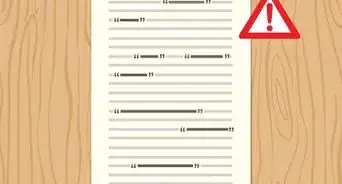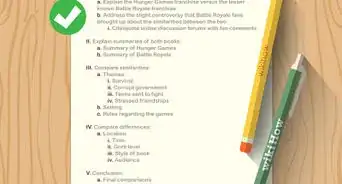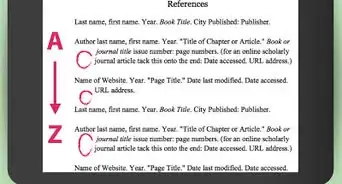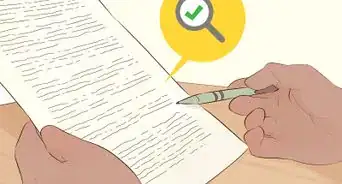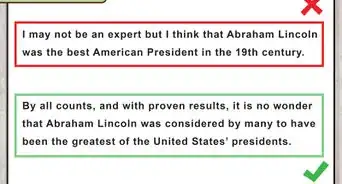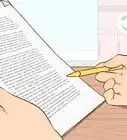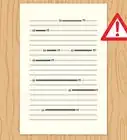This article was co-authored by Christopher Taylor, PhD. Christopher Taylor is an Adjunct Assistant Professor of English at Austin Community College in Texas. He received his PhD in English Literature and Medieval Studies from the University of Texas at Austin in 2014.
There are 13 references cited in this article, which can be found at the bottom of the page.
wikiHow marks an article as reader-approved once it receives enough positive feedback. This article has 12 testimonials from our readers, earning it our reader-approved status.
This article has been viewed 1,088,619 times.
Writing a synthesis essay requires the ability to digest information and present it in an organized fashion. While this skill is developed in high school and college classes, it translates to the business and advertising world as well. Scroll down to Step 1 to begin learning how to write a synthesis essay.
Steps
Examining Your Topic
-
1Understand the concept of a synthesis essay. The purpose of a synthesis essay is to make insightful connections between parts of a work, or multiple works, with the goal of ultimately presenting and supporting a claim about a topic. In other words, when you do research on a topic, you will look for connections that you can form into a solid perspective on a topic. The different types of synthesis essays can be categorized as follows:[1]
- Argument synthesis: This type of essay has a strong thesis statement that presents the writer's point of view. It organizes relevant information gathered from research in a logical manner to support the thesis' point of view. Business white papers known as position papers often take this form. This is the type of synthesis essay that students will write during the AP test.
- Review: Often written as a preliminary essay to an argument synthesis, a review essay is a discussion of what has been written previously on a topic, with a critical analysis of the sources covered. Its unstated thesis is usually that more research needs to be done in that area or that the topic problem has not been adequately addressed. This type of paper is common in social science classes and in medicine.
- Explanatory/background synthesis: This type of essay helps readers understand a topic by categorizing facts and presenting them to further the reader's understanding. It does not advocate a particular point of view, and if it has a thesis statement, the thesis is a weak one. Some business white papers take this form, although they are more likely to have a point of view, if understated.
-
2Choose a topic suitable for a synthesis essay. Your topic should be broad enough for pulling several related sources together, but not so broad as to bring widely disparate sources together. If you have free choice on a topic, some preliminary reading may help you decide what to write about. However, if you're writing a synthesis essay for a class, you may be assigned a topic or have to pick it from a list.[2]
- Example of a broad topic narrowed down into a reasonable synthesis essay topic: Instead of the broad topic of Social Media, you could discuss your view on the effects texting has had on the English language.
- If you've been assigned a topic as part of a class, make sure you read the prompt carefully and fully understand it.
Advertisement -
3Choose and read your sources carefully. If you are taking the AP test, your sources will be provided for you. You'll usually want to select at least three sources for your essay. If you have time after you study each of these sources thoroughly, it's a good idea to learn one or two more, if you have the time. Look for material within your sources that relates to the reason for writing your essay (what your argument is).[3]
- Keep in mind that it's better to do three sources well than to do five sources incompletely.
- Annotate each source by writing notes in the margins. This allows you to keep track of your train of thought, developing ideas, etc.
-
4Develop a thesis statement. Once you have read the sources you are provided with, or have done your own outside research, you will have to come up with an opinion on your topic. Your thesis will be the main idea presented in your essay. It should encompass the topic and state your point of view on that topic. It should be stated as a complete sentence. Depending on the essay, your thesis statement can be either the opening sentence of the essay itself or the last sentence of the first paragraph.[4]
- Example: Texting has had a positive impact on the English language as it has helped the millennial generation create their own form of the language.
-
5Re-read your source material for items to support your thesis. Go through your sources and pick out key quotes, statistics, ideas, and facts that support your thesis. As you find them, write them down. You will use these throughout your essay.
- If you wish to take on a claim by an opponent of your idea, and to poke holes in it, you should also find some ideas or quotes that go against your thesis statement, and plan ways to disprove them. This is called a concession, refutation, or rebuttal, which can strengthen your argument if you do it well.
- Example: For the thesis statement listed above, excellent sources would include quotes from linguists discussing the new words that have developed through 'text-speak', statistics that show the English language has evolved with almost every generation, and facts that show students still have the ability to write with the use of grammar and spelling (which your opponents would bring up as the main reason texting has had a negative effect on the English language).
Outlining Your Essay
-
1Outline the structure of your thesis. You can either do this as a formal outline or just plan it in your head, but you need to decide how to present your material for best effect. If you are writing this paper for the AP test, know that the graders will be looking for a specific structure. This structure is as follows:[5]
- The introductory paragraph: 1. An introductory sentence that acts as a hook, capturing the reader's interest. 2. Identification of the issue you will be discussing. 3. Your thesis statement.
- The body paragraphs: 1. Topic sentence that gives one reason to support your thesis. 2. Your explanation and opinion of the topic sentence. 3. Support from your sources that backs up the claim you just made. 4. Explanation of the significance of the source(s).
- The conclusion paragraph: 1. State further significance of your topic from the evidence and reasons you discussed in the essay. 2. A profound thought or thoughtful ending for your paper.
-
2Use a more creative structure to present your thesis. If you are not writing this argumentative synthesis essay for the AP test, you should plan to use a more elaborate structure than the one listed above. You can use one or more of these approaches to develop your essay:
- Example/illustration. This may be a detailed recount, summary, or direct quote from your source material that provides major support for your point of view. You may use more than one example or illustration, if your paper calls for it. You should not, however, make your paper a series of examples at the expense of supporting your thesis.
- Straw man. With this technique, you present an argument opposed to the argument stated in your thesis, then show the weaknesses and flaws of the counter-argument. This format shows your awareness of the opposition and your readiness to answer it. You present the counter-argument right after your thesis, followed by the evidence to refute it, and end with a positive argument that supports your thesis.[6]
- Concession. Essays with concessions are structured similar to those using the straw man technique, but they acknowledge the validity of the counter-argument while showing that the original argument is stronger. This structure is good for presenting papers to readers who hold the opposing viewpoint.
- Comparison and contrast. This structure compares similarities and contrasts differences between two subjects or sources to show the facets of both. Writing an essay with this structure requires a careful reading of your source material to find both subtle and major points of similarity and difference. This kind of essay can present its arguments source-by-source or by points of similarity or difference.
-
3Create an outline appropriate for a background or review synthesis essay. While most synthesis essays are entirely focused on stating and supporting a thesis, background and review essays explore the ideas found in the sources rather than focusing on the author's point of view.[7] There are two basic ways to structure these sort of synthesis essays:
- Summary. This structure presents summaries of each of your relevant sources, making a progressively stronger argument for your thesis. It provides specific evidence to support your point of view, but usually omits presenting your own opinions. It's most commonly used for background and review essays.
- List of reasons. This is a series of sub-points that flow from the main point of your paper as stated in its thesis. Each reason is supported with evidence. As with the summary method, reasons should become progressively more important, with the most important reason last.
Writing Your Essay
-
1Write your first draft according to your outline. Be prepared to deviate from your plan, however, if you find new ideas and information in your source material that supports your thesis. If you are writing the synthesis for the AP test, you will not have time to write more than one draft, so pace yourself and make it the best it can possibly be.
- Your essay should have an introductory paragraph that includes your thesis, a body to present evidence that supports your thesis, and a conclusion that summarizes your point of view.
-
2Write in the third person. Writing in the third person means using "he," "she," "it", and using complete, unambiguous sentences. Present enough information to show your credibility in the subject of your essay. You should write in the active voice as much as possible, although passive voice is acceptable in circumstances where you would otherwise use first ("I") or second person ("you").[8]
-
3Use transitions between paragraphs to make the text flow logically. Transitions are a great way to show places where your sources support one another: "Hallstrom's theory on price-fixing is supported by Pennington's paper 'Cliffhanger Economics,' where she makes the following points:"
- Lengthy quotes of three lines or more should generally be set off as block quotes to better call attention to them.[9]
Finalizing Your Essay
-
1Revise your essay. This is the time to strengthen arguments and improve transitions between points and paragraphs. You should try to make your argument as succinct and easy to follow as possible. It helps to read your essay out loud because when you read out loud, you are more likely to notice awkward sentences or incoherent arguments.[10]
- Ask someone else to proofread your paper. The saying “two heads are better than one” still holds true. Ask a friend or colleague what would they add or remove from the paper. Most importantly, does your argument make sense, and is it clearly supported by your sources?
-
2Proofread your paper. Read through your paper and look for any grammar, punctuation or spelling errors. Are all of the names and proper nouns spelled correctly? Are there any run-on sentences or fragments? Correct them as you go.[11]
- Read the paper aloud to guarantee that you don't accidentally add in or take out words when reading in your head.
- If you can, get a friend or classmate to proofread your essay as well.
-
3Cite your source material. For most papers, this means using footnotes to cite material in the body of your essay and a bibliography of cited works at the end. Footnotes and in-text citations should be used for any quoted, paraphrased, or cited material. If you are writing this essay for the AP test, you will not be using a specific style of citing but you will have to state which source you used after you cite it.[12]
- Example of citing in an AP synthesis essay: McPherson claims “texting has changed the English language in a positive way--it has given a new generation their own unique way to communicate” (Source E).
- For college essays, you'll most likely use MLA format. Whichever format you use, be consistent in its use. You may also be asked to use APA or Chicago style.
-
4Title your essay. Your title should reflect the point of view in your thesis statement and supporting arguments. Choosing your title last helps assure that the title fits your essay instead of writing your essay to fit the title.[13]
- Example title:: English and the iPhone: Exploring the Benefits of 'Text-Speak'
Outline Template
Community Q&A
-
QuestionWhile writing using the third person, is "we" appropriate?
 Community AnswerNo, try to avoid "We," "I," "you" or any personal or collective pronouns because then it's not third person or necessarily objective anymore. In most cases the writer's role in the paper doesn't matter at all.
Community AnswerNo, try to avoid "We," "I," "you" or any personal or collective pronouns because then it's not third person or necessarily objective anymore. In most cases the writer's role in the paper doesn't matter at all. -
QuestionHow do I prove a statement?
 Community AnswerInclude evidence that backs the statement up; be sure to refer to other, expert and scholarly sources like websites, books, articles, etc. You could also start your sentence like this: ''In the text it says '' _______________''. Then you have proven your statement.
Community AnswerInclude evidence that backs the statement up; be sure to refer to other, expert and scholarly sources like websites, books, articles, etc. You could also start your sentence like this: ''In the text it says '' _______________''. Then you have proven your statement. -
QuestionCan I have a title on a synthesis paper?
 Community AnswerYes, you definitely can! This helps the reader further understand the information.
Community AnswerYes, you definitely can! This helps the reader further understand the information.
References
- ↑ https://success.uark.edu/get-help/student-resources/synthesis-paper.php
- ↑ https://www.unr.edu/writing-speaking-center/student-resources/writing-speaking-resources/mapping-a-synthesis-essay
- ↑ https://www.bgsu.edu/content/dam/BGSU/learning-commons/documents/writing/synthesis/planning-synthesis-essay.pdf
- ↑ https://writingcenterofprinceton.com/synthesis-essays-a-step-by-step-how-to-guide/
- ↑ https://jan.ucc.nau.edu/dso6/synthesis.htm
- ↑ https://owl.excelsior.edu/argument-and-critical-thinking/logical-fallacies/logical-fallacies-straw-man/
- ↑ https://www.montgomery.k12.ky.us/userfiles/2062/Classes/38481/outline%20for%20synthesis%20essay.pdf?id=480293
- ↑ https://writingcommons.org/section/rhetoric/rhetorical-stance/point-of-view/third-person-point-of-view/
- ↑ https://owl.purdue.edu/owl/research_and_citation/mla_style/mla_formatting_and_style_guide/mla_formatting_quotations.html
- ↑ https://owl.purdue.edu/owl/general_writing/the_writing_process/proofreading/steps_for_revising.html
- ↑ https://owl.purdue.edu/owl/general_writing/the_writing_process/proofreading/proofreading_suggestions.html
- ↑ http://www.edhs.org/ourpages/auto/2010/5/17/41759867/Synthesis%20Essay%20Introduction.pdf
- ↑ https://writing.umn.edu/sws/assets/pdf/quicktips/titles.pdf
About This Article
To write a synthesis essay, start by coming up with a thesis statement that you can support using all of the sources you've read for your essay. For example, your thesis statement could be "Texting has had a positive impact on the English language." Once you've got your thesis, go through your sources to find specific quotes, facts, and statistics that back up your claim. Structure your essay so it has an introduction that includes your thesis statement, a body that includes your arguments and evidence, and a conclusion that wraps everything up. For more tips on structuring your synthesis essay, read on!




